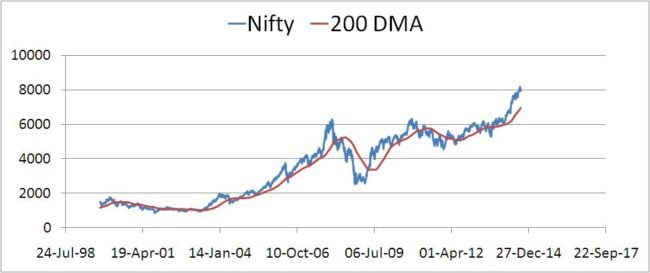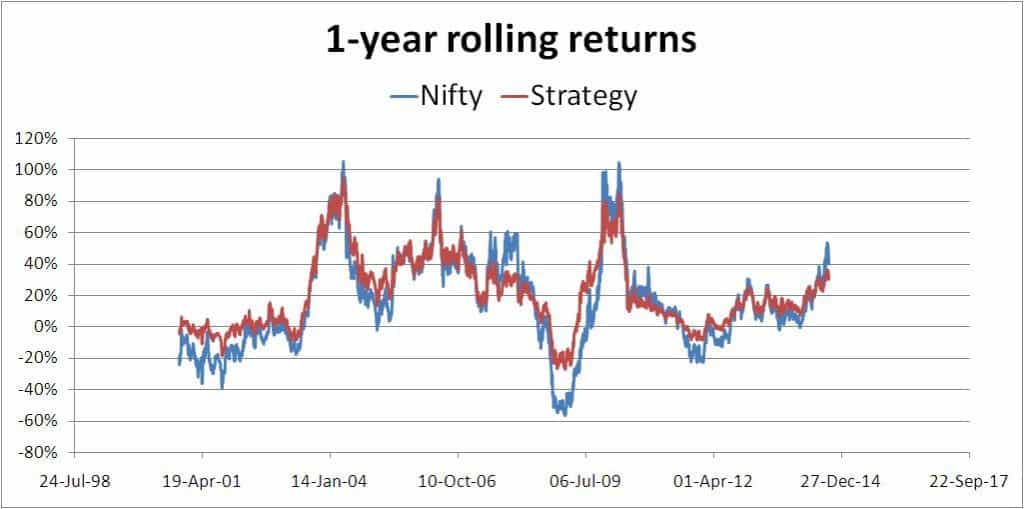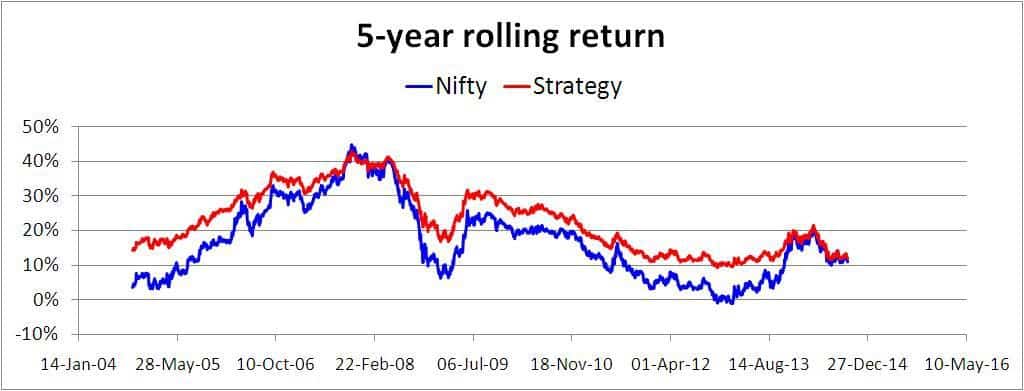Last Updated on July 23, 2017 at 4:49 pm
This post details a backtesting analysis based on the investment strategy to be adopted by the NFO IDFC Dynamic Equity Fund. It is inspired by a thread in facebook group Asan Ideas for Wealth started by Anup Maheswari.
IDFC Dynamic Equity Fund (IDEF) is a quantitative tactical asset allocation fund along the lines of Franklin’s PE fund and DSP BR Dynamic Asset allocation fund (see details here)
Investment Strategy
From scheme information document Excuse the long verbatim extract.
Extract Begins
Join 32,000+ readers and get free money management solutions delivered to your inbox! Subscribe to get posts via email! (Link takes you to our email sign-up form)
🔥Want to create a complete financial plan? Learn goal-based investing? Exclusive access to our DIY tools? Increase your income with your skills? Use this link to enjoy massive discounts on our robo-advisory tool & courses! 🔥
The scheme aims to dynamically manage equity and debt exposure in the portfolio. We are of the belief that such strategy will minimize the risk and optimize the risk return proposition for a long term investor.
The extent of equity exposure would be guided by an underlying quantitative model. The balance will be invested in debt and money market securities. The fund managers will follow a passive investment strategy and take equity exposure depending on opportunities available at various points in time based on the month-end weighted average PE ratio and 200 Day Moving Averages of the CNX Nifty Index.
Equity exposure:
Equity market exposure will be taken as per the quantitative model outputs. These exposures will then be passively maintained by tracking any of the market indices (subject to tracking error). The Scheme will endeavour to invest in stocks in a proportion that it is as close as possible to the weightages of these stocks in the underlying Index, taking into account the change in weights of stocks in the index as well as the incremental collections/redemptions from the Scheme.
The index to be invested in (tracked) will be determined on relative valuation of indices (month-end weighted average P/E ratio of the respective index) amongst themselves. The scheme proposes to track (subject to tracking error) CNX Nifty and CNX Nifty Junior indices as its investment universe. The Scheme will switch between indices when the current ratio of the indices’ PE ratios (PE of CNX Nifty/PE of CNX Nifty Junior) is above or below its 18 month standard deviation.
Debt exposure:
The scheme shall invest in various types of permitted debt and money market securities (including G-Sec) across maturities. The allocation to various types of debt / money market securities would be based on the fund manager’s view on interest rates and the market conditions.
Use of equity derivatives:
Under normal circumstances, the scheme shall primarily invest in equity and equity related instruments in the range of 65% to 100% and fixed income securities including money market instruments in the range of 0% to 35% for capital appreciation. The scheme will vary its investment in equity and equity related instruments and move towards exposure to equity derivatives when it needs to bring down the equity exposure below 65% depending upon the quantitative model.
In the periods where the model indicates a bullish market, the exposure of the scheme in equity and equity related instruments will increase of up to 100%. However, if the market movement reflects a bearish tint, the scheme will restrict its investment in equity to 65% and if necessary shall hedge this equity exposure in underlying stocks up to the extent of 35% of the portfolio by taking offsetting position in the derivative segment, therefore resulting into an equity market exposure going below 65% bringing it down up to 30%. In such a scenario the balance will be invested into debt market instruments.
Determining the equity exposure:
A quantitative model will be used to determine the exposure in equity and debt markets. The portfolio shall be rebalanced on the last working day of the second week of every month.
The quantitative model approach used to determine the equity and debt allocation employs valuation and momentum factors namely month-end weighted average P/E Ratio and 200 Day Moving Averages (“DMA”) of CNX Nifty index. Valuation (P/E ratio) is used to determine whether markets are cheap or expensive relative to their 10 year history. We believe that the P/E ratio captures broader market valuations very well and thus helps judge market cycles while the moving average (200 DMA) help determine near term market sentiment.
Extract Ends
The funds asset allocation will follow a two step approach. First, the band in which monthly average of the Nifty PE falls is determined. Then depending on the 200 day daily moving average, the equity allocation will be fixed.
I was curious to check how this strategy works using past Nifty data. I have used the same asset allocation strategy but with only one index – the Nifty.
Unlike the fund I have assumed changes to the equity allocation on a daily basis (possible only on Excel!).
Analysis Procedure
1) Monthly average of Nifty PE was computed.
2) The equity allocation was determined with this on the above basis
3) The daily index returns were computed.
4) The daily fund-strategy return was computed according to the calculated equity allocation.
5) The 1-year and 5-year rolling returns for the index and the fund-strategy were computed.
Note: This analysis brings out the flavour of the funds strategy and is not an attempt to replicate what the fund aims to do.
The 200 Day Daily Moving Average (DMA)
Notice that when the Nifty is above the 200-DMA, it represents an upward trend and when the Nifty is below the 200-DMA, it represents a downward trend. In a sideways market, the Nifty could repeatedly cross the DMA either way.
The 1-year rolling returns
Notice that outlined strategy is less volatile than the Nifty. It has good downside protection and at the same time does not lose out too much when there is an upswing.
The 5-year rolling returns
This results in superior ‘long-term’ (relative to 1-year!) performance. The outlined strategy seems to have comfortably beaten the Nifty.
I will discuss more about such tactical asset allocation strategies (including Franklin’s PE fund) in future posts.
Impression:
IDFC Dynamic Equity Fund seems to be a better bet than DSP BR Dynamic Asset Allocation Fund (which in my opinion is a dud. The yield gap strategy it follows is too conservative and will lose out during bull runs).
IDEF’s strategy appears to be much better in this regard. Unlike the DSP BR fund (which is a fund of fund) this is an ‘active’ index fund!
Franklin’s PE fund has a decent track record and it will be interesting to see how IDEF compares with it down the line.
Existing equity mf investors can give this fund a miss. For first time investors, this could be a suitable entry fund, provided they do not mindlessly buy other funds down the line.

Use our Robo-advisory Tool to create a complete financial plan! ⇐More than 3,000 investors and advisors use this! Use the discount code: robo25 for a 20% discount. Plan your retirement (early, normal, before, and after), as well as non-recurring financial goals (such as child education) and recurring financial goals (like holidays and appliance purchases). The tool would help anyone aged 18 to 80 plan for their retirement, as well as six other non-recurring financial goals and four recurring financial goals, with a detailed cash flow summary.
🔥You can also avail massive discounts on our courses and the freefincal investor circle! 🔥& join our community of 8000+ users!
Track your mutual funds and stock investments with this Google Sheet!
We also publish monthly equity mutual funds, debt and hybrid mutual funds, index funds, and ETF screeners, as well as momentum and low-volatility stock screeners.
You can follow our articles on Google News

We have over 1,000 videos on YouTube!

Join our WhatsApp Channel



- Do you have a comment about the above article? Reach out to us on Twitter: @freefincal or @pattufreefincal
- Have a question? Subscribe to our newsletter using the form below.
- Hit 'reply' to any email from us! We do not offer personalised investment advice. We can write a detailed article without mentioning your name if you have a generic question.
Join 32,000+ readers and get free money management solutions delivered to your inbox! Subscribe to get posts via email! (Link takes you to our email sign-up form)
About The Author
 Dr M. Pattabiraman (PhD) is the founder, managing editor and primary author of freefincal. He is an associate professor at the Indian Institute of Technology, Madras. He has over 13 years of experience publishing news analysis, research and financial product development. Connect with him via Twitter(X), LinkedIn, or YouTube. Pattabiraman has co-authored three print books: (1) You can be rich too with goal-based investing (CNBC TV18) for DIY investors. (2) Gamechanger for young earners. (3) Chinchu Gets a Superpower! for kids. He has also written seven other free e-books on various money management topics. He is a patron and co-founder of “Fee-only India,” an organisation promoting unbiased, commission-free, AUM-independent investment advice.
Dr M. Pattabiraman (PhD) is the founder, managing editor and primary author of freefincal. He is an associate professor at the Indian Institute of Technology, Madras. He has over 13 years of experience publishing news analysis, research and financial product development. Connect with him via Twitter(X), LinkedIn, or YouTube. Pattabiraman has co-authored three print books: (1) You can be rich too with goal-based investing (CNBC TV18) for DIY investors. (2) Gamechanger for young earners. (3) Chinchu Gets a Superpower! for kids. He has also written seven other free e-books on various money management topics. He is a patron and co-founder of “Fee-only India,” an organisation promoting unbiased, commission-free, AUM-independent investment advice.Our flagship course! Learn to manage your portfolio like a pro to achieve your goals regardless of market conditions! ⇐ More than 3,500 investors and advisors are part of our exclusive community! Get clarity on how to plan for your goals and achieve the necessary corpus no matter the market condition!! Watch the first lecture for free! One-time payment! No recurring fees! Life-long access to videos! Reduce fear, uncertainty and doubt while investing! Learn how to plan for your goals before and after retirement with confidence.
Increase your income by getting people to pay for your skills! ⇐ More than 800 salaried employees, entrepreneurs and financial advisors are part of our exclusive community! Learn how to get people to pay for your skills! Whether you are a professional or small business owner seeking more clients through online visibility, or a salaried individual looking for a side income or passive income, we will show you how to achieve this by showcasing your skills and building a community that trusts and pays you. (watch 1st lecture for free). One-time payment! No recurring fees! Life-long access to videos!
Our book for kids: “Chinchu Gets a Superpower!” is now available!


Must-read book even for adults! This is something that every parent should teach their kids right from their young age. The importance of money management and decision making based on their wants and needs. Very nicely written in simple terms. - Arun.Buy the book: Chinchu gets a superpower for your child!
How to profit from content writing: Our new ebook is for those interested in getting a side income via content writing. It is available at a 50% discount for Rs. 500 only!
Do you want to check if the market is overvalued or undervalued? Use our market valuation tool (it will work with any index!), or get the Tactical Buy/Sell timing tool!
We publish monthly mutual fund screeners and momentum, low-volatility stock screeners.
About freefincal & its content policy. Freefincal is a News Media organisation dedicated to providing original analysis, reports, reviews and insights on mutual funds, stocks, investing, retirement and personal finance developments. We do so without conflict of interest and bias. Follow us on Google News. Freefincal serves more than three million readers a year (5 million page views) with articles based only on factual information and detailed analysis by its authors. All statements made will be verified with credible and knowledgeable sources before publication. Freefincal does not publish paid articles, promotions, PR, satire or opinions without data. All opinions will be inferences backed by verifiable, reproducible evidence/data. Contact Information: To get in touch, please use our contact form. (Sponsored posts or paid collaborations will not be entertained.)
Connect with us on social media
- Twitter @freefincal
- Subscribe to our YouTube Videos
- Posts feed via Feedburner.
Our publications
You Can Be Rich Too with Goal-Based Investing
 Published by CNBC TV18, this book is designed to help you ask the right questions and find the correct answers. Additionally, it comes with nine online calculators, allowing you to create custom solutions tailored to your lifestyle. Get it now.
Published by CNBC TV18, this book is designed to help you ask the right questions and find the correct answers. Additionally, it comes with nine online calculators, allowing you to create custom solutions tailored to your lifestyle. Get it now.Gamechanger: Forget Startups, Join Corporate & Still Live the Rich Life You Want
 This book is designed for young earners to get their basics right from the start! It will also help you travel to exotic places at a low cost! Get it or gift it to a young earner.
This book is designed for young earners to get their basics right from the start! It will also help you travel to exotic places at a low cost! Get it or gift it to a young earner.Your Ultimate Guide to Travel
 This is an in-depth exploration of vacation planning, including finding affordable flights, budget accommodations, and practical travel tips. It also examines the benefits of travelling slowly, both financially and psychologically, with links to relevant web pages and guidance at every step. Get the PDF for Rs 300 (instant download)
This is an in-depth exploration of vacation planning, including finding affordable flights, budget accommodations, and practical travel tips. It also examines the benefits of travelling slowly, both financially and psychologically, with links to relevant web pages and guidance at every step. Get the PDF for Rs 300 (instant download)


